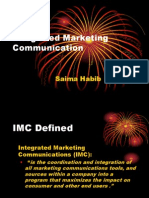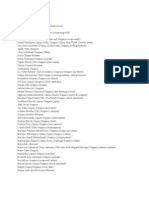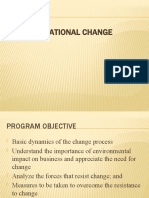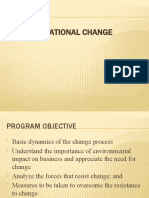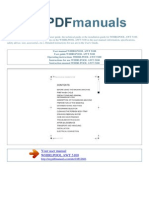Business Crisis in Any Organization in India in Terms of
Business Crisis in Any Organization in India in Terms of
Uploaded by
FISB_TaniyaCopyright:
Available Formats
Business Crisis in Any Organization in India in Terms of
Business Crisis in Any Organization in India in Terms of
Uploaded by
FISB_TaniyaOriginal Title
Copyright
Available Formats
Share this document
Did you find this document useful?
Is this content inappropriate?
Copyright:
Available Formats
Business Crisis in Any Organization in India in Terms of
Business Crisis in Any Organization in India in Terms of
Uploaded by
FISB_TaniyaCopyright:
Available Formats
business crisis in any organization in India in terms of Nature and types of crisis, physical /
non-physical damage type of crisis; the different stages of crisis and its consequences? (2 pages)
On October 2003, just a month before Diwali, the Food and Drug Administration Commissioner received complaints about infestation in two bars of Cadbury Dairy Milk, Cadbury Indias flagship brand with over 70% market share. He ordered an enquiry and went directly to the media with a statement. Over the following 3-week period, resultant adverse media coverage touched close to 1000 clips in print and 120 on TV news channels. In India, where Cadbury is synonymous with chocolate, the companys reputation and credibility was under intense scrutiny. Sales volumes came down drastically in the first 10 weeks, which was the festival season; retailer stocking and display dropped, employee morale especially that of the sales team was shaken. The challenge was to restore confidence in the key stakeholders (consumers, trade and employees, particularly the sales team) and build back credibility for the corporate brand through the same channels (the media) that had questioned it. In defense, Cadbury issued a statement that the infestation was not possible at the manufacturing stage and poor storage at the retailers was the most likely cause of the reported case of worms. But the FDA didnt buy that. FDA commisioner, Uttam Khobragade told CNBC-TV18, It was presumed that worms got into it at the storage level, but then what about the packing packaging was not proper or airtight, either ways its a manufacturing defect with unhygienic conditions or improper packaging. That was followed by allegations and counter-allegations between Cadbury and FDA. The heat of negative publicity melted Cadburys sales by 30 per cent, at a time when it sees a festive spike of 15 per cent. For the first time, Cadburys advertising went off air for a month and a half after Diwali, following the controversy. Consumers seemed to ignore their chocolate cravings. Remedy: A focused and intense communications program was implemented over the next six months to rebuild credibility and restore confidence among the key stakeholders. The results: In media, the key message that infestation was a storage-linked problem, not manufacturing related,found widespread acceptance. Across the board, media carried Cadburys point-of-view on the issue. Sales volumes climbed back to almost to pre-crisis levels eight weeks after the launch of new packaging a concrete step taken by the company to minimize the incidence of infestation. This reflected consumer confidence in the brand and the company. There was significant upward movement in ratings amongst consumers on parameters like companys image, responsiveness of company and behavioral parameters like intention to buy Cadbury chocolates. The last two helped to restore faith in the corporate brand among the trade and employees. Marketing Challenges and Objectives The incident came close on the heels of a cola controversy where a scientific laboratory declared colas unsafe due to high levels of pesticide. The jury was still out on that issue and so this incident acquired political overtones with parties decrying Cadbury as an irresponsible MNC. Andrea Dawson- Shepherd,
Global Corporate Communication Counsel, Cadbury Schweppes called it the worst worm infestationrelated crisis anywhere in the world. The immediate objective was to get the following key messages across: Infestation could never occur at the manufacturing stage The problem was storage linked; this without alienating trade channels Cadbury Dairy Milk continued to be safe for consumption The challenge was to restore confidence in the key stakeholders (trade and employees, particularly salespersons) and build back credibility for the corporate brand through the same channels (the media) that questioned it. Strategy: It was decided from the start to address the issue head-on and take whatever steps were necessary to restore confidence. Having historically maintained a low profile with the media and let its brands and its performance speak for it, the company began to cultivate relationships with the media and turn it into an ally and a credible, independent endorser to rebuild stakeholder confidence. Phase 1: Presenting Cadburys view (October-December 2003) The day the crisis broke, the agency set up a media desk to ensure that no media query went unanswered. From Day 1 every story carried Cadburys point of view.At the first media briefing organised by the agency, the Cadburys Managing Director addressed consumer concerns with the following key messages: Infestation is a storage linked problem. It is safe to eat Cadbury chocolates. Consumers must exercise the same care in purchasing a chocolate as they would when buying any food item. At a second media briefing about two weeks after the first incident was reported, Cadbury announced significant steps to restore consumer confidence. Called Project Vishwas (Trust), this entailed: A retail monitoring and education program undertaken on a war footing to address storage problems. Significant packaging changes to reduce dependency on storage conditions as much as possible to be launched within two months. An Editorial Outreach program with 31 media editors across 5 most affected cities was orchestrated by the agency to get senior Cadbury spokespeople to share their version of events in one-on-one meetings. The trade, and consumers, were reached nationally through a press ad Facts about Cadbury, released in 55 publications in 11 languages. It presented facts about Cadbury manufacturing and storage and highlighted corrective steps being taken by the company. This was a public statement of the corporate stand on the issue. The trade was supported with posters and leaflets to help them share Cadbury pointof-view with their customers. A response cell with a toll free number and an e-mail id were put in place to give trade a means to directly contact the company with any issues they faced- reinforcing the companys commitment to quality. From the beginning, a series of town hall meetings were held with senior managers addressing employees to ensure they were updated on the proactive actions being taken by Cadbury to manage media, help trade and ensure future occurrences of such incidents were kept to the minimum. Regular email updates
from the MD were also used to communicate the companys point of view and to ensure consistency of messaging since employees are the companys ambassadors. Phase 2: Packaging change (January- March 2004) The new purity sealed packaging was launched in January 2004. By investing up to Rs 15 crore (Rs 150 million) on imported machinery, Cadburys revamped the packaging of Dairy Milk. The metallic poly-flow, was costlier by 10-15 per cent, but Cadbury didnt hike the pack price.This entailed double wrapping for maximum protection to reducing the possibility of infestation. This was a big step involving investment of millions of dollars and getting on stream a production process in 8 weeks, that would normally take about six months. To communicate these significant changes the company was making, Cadbury brought in a brand ambassador to reinforce the credibility that the company had demonstrated through its actions. Amitabh Bachchan, a legendary Indian film star, was chosen, as he embodied the values of Cadbury as a brand and connected with all of India mothers, teenagers, children, media persons and trader partners. A media conference was organized in Mumbai to launch the new packaging. And this was followed with press conferences in cities worst affected by the crisis Pune and Nagpur in Maharashtra and Cochin in Kerala. In these conferences, media persons were encouraged to compare the old and new packs with an innovative comparison kit and experience the significant changes in packaging first hand. An audio visual with a message from Amitabh Bachchan, was beamed to build credibility and excitement. Given that much of the damage had come from television coverage, a video news release with packaging shots and factory shots was given to television channels to control the visual messaging. Simultaneously, senior Cadbury spokespersons had one-on-ones with the Editors of the Outreach program initiated in November 2003. Another audio visual with a message from the star was used in a series of sales conferences to enthuse and reassure salespersons. And this helped to rebuild confidence in the salespersons to go and sell the product more convincingly and confidently to the trade. The announcement of the new pack was done through a testimonial advertisement on TV called Sincerity. It consciously addressed the problem headon, with the superstar talking straight into camera about how before doing the ad he first convinced himself about the quality of Cadbury chocolates by visiting the factory. Consumers respected the brand for not skirting the issue but acknowledging it and giving a solution to the problem This was Public Relations using a TV Commercial to get key messages across! Results: Media Coverage: The media relationship effort clearly helped in making media accept that the infestation was genuinely caused by storage-linked problems. From the start, all media reports carried the Cadburys point-of-view. Bad news automatically gets great coverage. However, the agency helped Cadbury get a total of 378 clips in over 11 languages covering the new packaging, and its benefits, in January 2004. The Business Today clip is a typical representation of the changed media perception and a better understanding of the problem over a three month period. Sales: Sales volumes, which declined drastically between week 1 and week 10 of crisis, climbed back almost to the pre-incident levels by week. within 8 weeks of introduction of new packaging and communication. This is a clear reflection of restoration of consumer and hence trade confidence in the corporate brand.
Image: There was significant upward movement in ratings amongst consumers on parameters like company image, responsiveness of company and behavioral parameters like intention to buy Cadbury chocolates. While the new product introduction and advertising had their role to play in the changing consumer perceptions, the medias positive coverage and the trades positive pre-disposition played a huge part in helping Cadbury regain its reputation in the market. Notes: Role of Public relations PR concerns the total communications of your total organization/group of organizations. It is unlike advertising, where you are sharing skills of planning, creative and media buying teams with an outsourced agency. PR calls for a very intimate understanding of the total inner workings of your organisation at all levels workers to Board levels. It requires the integration of knowledge and communications. It is not a part time job for a Marketing Services Manager. If it is to work and serve the larger objective, the PR department should be independent, servicing others like production, personnel, marketing, finance, corporate agendas. Therefore, the PR Head should be part of the top management team reporting directly to the CEO. He also needs to share everyones confidences. The PR department of Cadburys played a very effective role in managing the reputation and keeping up the goodwill of the company.
You might also like
- Harry Potter and HedwigDocument31 pagesHarry Potter and HedwigMaria Eva Perez94% (16)
- Laundry FormsDocument5 pagesLaundry FormsJohn Joseph AmilerNo ratings yet
- Le Pain Quotidien Cookbook 2013Document11 pagesLe Pain Quotidien Cookbook 2013PQLicensing100% (1)
- Cadbury Worm Controversy 2Document6 pagesCadbury Worm Controversy 2Aanchal SoniNo ratings yet
- Cadbury Case StudyDocument3 pagesCadbury Case Studyashish4485No ratings yet
- Assignment On Cadbury Management CrisisDocument6 pagesAssignment On Cadbury Management CrisisFarzana Khan100% (3)
- Cadbury CaseDocument5 pagesCadbury CaseDurgesh AgrawalNo ratings yet
- Cadbury: Case Study OnDocument6 pagesCadbury: Case Study OnZaidi1No ratings yet
- CM Case Study - Cadbury & NestleDocument8 pagesCM Case Study - Cadbury & NestleNurul Hana OmarNo ratings yet
- Case Study - Cadbury Crisis Management (Worm Controversy) - MBA Knowledge BaseDocument4 pagesCase Study - Cadbury Crisis Management (Worm Controversy) - MBA Knowledge Baseersubha0% (2)
- Case For Crisis ManagementDocument4 pagesCase For Crisis Managementshivasingh0593No ratings yet
- Case Study Cadbury Crisis ManagementDocument6 pagesCase Study Cadbury Crisis Managementtanisha guptaNo ratings yet
- Cadbury's Battle of WormsDocument6 pagesCadbury's Battle of WormsJulekha AnjumNo ratings yet
- Cadbury IMC CaseDocument2 pagesCadbury IMC CaseMBA QT 2021No ratings yet
- Cadbury Crisis ManagementDocument8 pagesCadbury Crisis ManagementShrestha ChandaNo ratings yet
- Crisis ManagementDocument10 pagesCrisis ManagementShikha ThakurNo ratings yet
- MarketingDocument21 pagesMarketingmaradani manoharNo ratings yet
- Cadbury Crisis Management (Worm Controversy) 1. Introduction & Theories AppliedDocument6 pagesCadbury Crisis Management (Worm Controversy) 1. Introduction & Theories AppliedKîràñ P GûrâvNo ratings yet
- Cad BuryDocument19 pagesCad BuryClyde Timizo AndradeNo ratings yet
- Cad Burry YyDocument5 pagesCad Burry Yyatul daveNo ratings yet
- Cadbury CasseDocument3 pagesCadbury CasseAnshula KolheNo ratings yet
- Case Study On Carbury Dairy Milk ChoclateDocument3 pagesCase Study On Carbury Dairy Milk ChoclateDivesh VithalNo ratings yet
- Cadbury Crisis - Leadership CourseDocument9 pagesCadbury Crisis - Leadership CourseArpita Gupta IPM (BA) 2020 BatchNo ratings yet
- CADBURY Dairy Milk Case StudyDocument6 pagesCADBURY Dairy Milk Case StudyANOLI2593100% (1)
- Management Concepts - CIA 2 - Crisis Management - FinalDocument20 pagesManagement Concepts - CIA 2 - Crisis Management - FinalDivyendhu ChowdaryNo ratings yet
- Case CadburyDocument6 pagesCase CadburyReema NegiNo ratings yet
- Case Study On: Cadbury India-Worms Controversy & Brand ReputationDocument9 pagesCase Study On: Cadbury India-Worms Controversy & Brand ReputationsonikriNo ratings yet
- Cadbury Case Final 2012Document10 pagesCadbury Case Final 2012Pramod YadavNo ratings yet
- Regarding Public RelationsDocument7 pagesRegarding Public RelationssnehamorabNo ratings yet
- Public Relation and Corporate Image Crisis Management: Name Abdur Rahman Enrollment No A90606417180 Course BBA 6BDocument11 pagesPublic Relation and Corporate Image Crisis Management: Name Abdur Rahman Enrollment No A90606417180 Course BBA 6BAbdur RahmanNo ratings yet
- Crisis ManagementDocument26 pagesCrisis ManagementSebin Sebastian100% (2)
- Presented By: Piyush Gupta Vishakha Mishra Jyoti Rawat Ruby SharmaDocument19 pagesPresented By: Piyush Gupta Vishakha Mishra Jyoti Rawat Ruby SharmaPiyush GuptaNo ratings yet
- Cadbury 2Document3 pagesCadbury 2Udipta MohanNo ratings yet
- Cadbury Crisis ManagementDocument11 pagesCadbury Crisis ManagementHaris MusakhelNo ratings yet
- Cadbury Crisis MangementDocument8 pagesCadbury Crisis MangementShivangi RathiNo ratings yet
- Integrated Marketing Communication: Saima HabibDocument24 pagesIntegrated Marketing Communication: Saima HabibSayima HabibNo ratings yet
- Cadbury India Limited - The "Worm" CrisisDocument4 pagesCadbury India Limited - The "Worm" CrisisTejas PatelNo ratings yet
- Cadburry and OgilvyDocument19 pagesCadburry and OgilvyVishrut SharmaNo ratings yet
- Comparative Analysis On The PR Activities by CADBURYDocument18 pagesComparative Analysis On The PR Activities by CADBURYhetal902357100% (1)
- IMC Tools Used in The CampaignDocument2 pagesIMC Tools Used in The CampaignUdipta MohanNo ratings yet
- Case StudyDocument6 pagesCase StudyAlyana MaestradoNo ratings yet
- Advertisement ManagementDocument19 pagesAdvertisement ManagementPushkar KaushikNo ratings yet
- Cadbury FinalDocument25 pagesCadbury Finalgaurav_agrawal_4No ratings yet
- Cadbury Case StudyDocument5 pagesCadbury Case StudyAliciaNo ratings yet
- PR Fiascos - Crisis Management & Crisis Communication PlansDocument10 pagesPR Fiascos - Crisis Management & Crisis Communication PlansOmerAhmedKhanNo ratings yet
- Managerial Communication in Times of Crisis: Cadbury India: A Fight To Worm RumourDocument8 pagesManagerial Communication in Times of Crisis: Cadbury India: A Fight To Worm RumourDanish NasirNo ratings yet
- Cadbury Worm Case: Presented by HUL GROUP NO:8Document6 pagesCadbury Worm Case: Presented by HUL GROUP NO:8..sravana karthikNo ratings yet
- Marketing Strategies During The PandemicDocument9 pagesMarketing Strategies During The PandemicSathish BNo ratings yet
- Cadbury Case StudyDocument14 pagesCadbury Case StudyShruti MukherjeeNo ratings yet
- Political Social Economic Military Affairs: A Term That Refers To A Three-Stage ProcessDocument16 pagesPolitical Social Economic Military Affairs: A Term That Refers To A Three-Stage ProcessMohammed YunusNo ratings yet
- Cadbury Dairy Milk ReportDocument36 pagesCadbury Dairy Milk ReportArun HariharanNo ratings yet
- Assignment MarketingDocument6 pagesAssignment MarketingBindu Gaire SharmaNo ratings yet
- R1-The 4 Phases of Marketing Communication During Covid-19Document5 pagesR1-The 4 Phases of Marketing Communication During Covid-19Tanu GuptaNo ratings yet
- Bread SpreadDocument7 pagesBread SpreadChetanBansalNo ratings yet
- KFC Goes FCKDocument16 pagesKFC Goes FCKPankaj PatelNo ratings yet
- KFC To FCK-9Document16 pagesKFC To FCK-9mohsinziaNo ratings yet
- Case Study - Cadbury World: Submitted By: BSMA 1102 Group 9Document14 pagesCase Study - Cadbury World: Submitted By: BSMA 1102 Group 9Marie Remelyn AalaNo ratings yet
- Crisis ManagementDocument39 pagesCrisis ManagementFaizan Ahmad100% (1)
- Cadbury Crisis in IndiaDocument6 pagesCadbury Crisis in IndiaKushagra VarmaNo ratings yet
- Building Brand Equity: The Importance, Examples & How to Measure ItFrom EverandBuilding Brand Equity: The Importance, Examples & How to Measure ItNo ratings yet
- Kellogg on Advertising and Media: The Kellogg School of ManagementFrom EverandKellogg on Advertising and Media: The Kellogg School of ManagementBobby J. CalderRating: 3 out of 5 stars3/5 (1)
- Citizen Brand: 10 Commandments for Transforming Brands in a Consumer DemocracyFrom EverandCitizen Brand: 10 Commandments for Transforming Brands in a Consumer DemocracyNo ratings yet
- Connective Branding: Building Brand Equity in a Demanding WorldFrom EverandConnective Branding: Building Brand Equity in a Demanding WorldNo ratings yet
- AutomobileDocument2 pagesAutomobileFISB_TaniyaNo ratings yet
- Organizational Change: Dr. Gary J. Evans, PMPDocument67 pagesOrganizational Change: Dr. Gary J. Evans, PMPFISB_TaniyaNo ratings yet
- Integrating HR & Talent Management Processes: Succession PlanningDocument10 pagesIntegrating HR & Talent Management Processes: Succession PlanningFISB_TaniyaNo ratings yet
- Organizational ChangeDocument13 pagesOrganizational ChangeFISB_TaniyaNo ratings yet
- Organizational ChangeDocument13 pagesOrganizational ChangeFISB_TaniyaNo ratings yet
- Organizational ChangeDocument13 pagesOrganizational ChangeFISB_TaniyaNo ratings yet
- Secondary: Qualitative ResearchDocument5 pagesSecondary: Qualitative ResearchFISB_TaniyaNo ratings yet
- Rice Cooker: AutomaticDocument8 pagesRice Cooker: AutomaticFlor Vegas VoirolNo ratings yet
- Walmart Value Chain AnalysisDocument21 pagesWalmart Value Chain AnalysisRafaa Dalvi100% (1)
- Astm F406-08Document22 pagesAstm F406-08Nguyen JamesNo ratings yet
- Quilt City TrafficDocument5 pagesQuilt City TrafficMirela1607100% (1)
- Gerard Way X ReaderDocument3 pagesGerard Way X ReaderHenry TomasinoNo ratings yet
- Jacob S. Kelston: EducationDocument8 pagesJacob S. Kelston: Educationjakekelston2992No ratings yet
- Summer Training Project Report: ON A Study On Customer Preference For Coca-Cola Brands With Reference To Coca-Cola"Document90 pagesSummer Training Project Report: ON A Study On Customer Preference For Coca-Cola Brands With Reference To Coca-Cola"goswamiphotostatNo ratings yet
- Layout StrategiesDocument67 pagesLayout StrategiesPaula Galvan100% (2)
- PRICE LIST (CP - 90) RevDocument20 pagesPRICE LIST (CP - 90) RevBobby IskandarNo ratings yet
- Ies Inv MGMTDocument59 pagesIes Inv MGMTDarshana ShahNo ratings yet
- MCQ P Amp MMDocument15 pagesMCQ P Amp MMArjun Cardoza100% (1)
- Wrap Skirt InstructionsDocument14 pagesWrap Skirt InstructionsLucija CrljenkoNo ratings yet
- F083 EskimoGirlsCardiDocument4 pagesF083 EskimoGirlsCardinata westNo ratings yet
- Slide 18 Column A Column B Column CDocument2 pagesSlide 18 Column A Column B Column CNadia Caoile IgnacioNo ratings yet
- KeychainDocument1 pageKeychainBordados Industriales AndesNo ratings yet
- Avon - Case StudyDocument8 pagesAvon - Case StudyHina KhanNo ratings yet
- Docu BakingDocument3 pagesDocu Bakingako judel75% (12)
- Learn To Sew! Sewing GlossaryDocument3 pagesLearn To Sew! Sewing GlossaryiliiexpugnansNo ratings yet
- A Study On Expectations of Rural Consumer Towards Organized Retailing: A ReviewDocument10 pagesA Study On Expectations of Rural Consumer Towards Organized Retailing: A ReviewAnkush MehtaNo ratings yet
- Sumatif QuestionsDocument8 pagesSumatif QuestionsvassugiNo ratings yet
- AHA - Aluminum Windows Installation - 14-3-2019 Revie-2Document6 pagesAHA - Aluminum Windows Installation - 14-3-2019 Revie-2Eyal BabuNo ratings yet
- Sabudana Vada: IngredientsDocument2 pagesSabudana Vada: IngredientskparvezaliNo ratings yet
- Business Strategy WalmartDocument13 pagesBusiness Strategy WalmartTheWritersNo ratings yet
- MN House & Sunday Sales: Comparing MN Beer Activists Survery & MN Family Council Voter GuideDocument4 pagesMN House & Sunday Sales: Comparing MN Beer Activists Survery & MN Family Council Voter GuideSally Jo SorensenNo ratings yet
- User Manual Whirlpool Awt 5100 eDocument2 pagesUser Manual Whirlpool Awt 5100 eCiprian Ionuț Bongeag0% (1)
- Re Branding Lego ThesisDocument46 pagesRe Branding Lego ThesisjlhgrNo ratings yet
- Clothing Fashions: Fashion Is A General Term For A Popular Style or Practice, Especially in Clothing, Foot Wear, orDocument6 pagesClothing Fashions: Fashion Is A General Term For A Popular Style or Practice, Especially in Clothing, Foot Wear, orMonica MoralesNo ratings yet



































